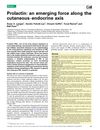TLDR Epithelial proliferation and hyperkeratosis are linked to gastric ulcers in pigs.
The study investigated the keratin expression patterns in the gastric pars oesophagea of pigs to understand the susceptibility to ulceration. It found that keratin pairs K 4/K 13 and K 5/K 14 were similarly expressed in both normal and affected epithelia. However, markers for hyperproliferative conditions (LL020 and LHK6) were present in the hyperkeratotic and ulcerated epithelium but not in normal tissue, indicating that K 6 expression is associated with mucosal changes. The findings suggested that epithelial proliferation and hyperkeratosis are linked to the development of gastric ulcers in pigs.
46 citations
,
May 1995 in “Proceedings of the National Academy of Sciences” A specific gene region can control targeted and responsive gene expression in mice, useful for skin disorder treatments.
248 citations
,
April 1988 in “Differentiation” Human and bovine hair follicles have distinct cytokeratins specific to hair-forming cells.
135 citations
,
November 1987 in “Differentiation” Outer root sheath cells consistently express certain keratins influenced by their environment.
 51 citations
,
July 2010 in “Trends in Endocrinology and Metabolism”
51 citations
,
July 2010 in “Trends in Endocrinology and Metabolism” Prolactin may play a significant role in skin and hair health and could be a target for treating skin and hair disorders.
 September 2021 in “Research Square (Research Square)”
September 2021 in “Research Square (Research Square)” Not having enough or having too much of the protein Grainyhead-like 3 leads to various developmental problems.
12 citations
,
May 2021 in “The journal of investigative dermatology/Journal of investigative dermatology” Laminin 332 is essential for normal skin cell behavior and structure.
18 citations
,
January 2013 in “Journal of Investigative Dermatology” WIF1 helps keep skin stem cells inactive to prevent excessive cell growth.
 2 citations
,
January 2011 in “Dental Medicine Research”
2 citations
,
January 2011 in “Dental Medicine Research” Keratin 75 might be important in oral cancer progression.



